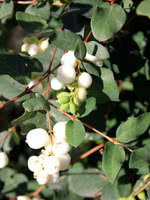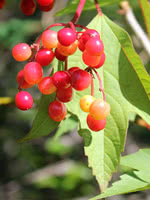Mon-Fri 9am - 5pm Mountain time
Common Snowberry vs Highbush Cranberry
Symphoricarpos albus
Viburnum trilobum
COMING SOON
(new stock expected: fall of 2025)
NOT AVAILABLE THIS SEASON - MIGHT RETURN
(new stock expected: fall of 2026)
Common Snowberry is a small deciduous shrub with characteristic white to pink flowers and clusters of white fruit.
This North American native species is very adaptable, and can be used for erosion control in riparian and restoration areas. Snowberry's fruit attracts wildlife, and livestock can consume the berries without issue.
Highbush Cranberry produces attractive white flowers in late June and bears edible fruit that matures to a bright red colour in the late summer.
This shrub, native to much of Canada, is fast growing, and its fruit can be eaten raw or cooked into a sauce.
Common Snowberry Quick Facts
Highbush Cranberry Quick Facts
Toxicity: berries toxic to humans
In row spacing: 0.6 m (2.0 ft)

